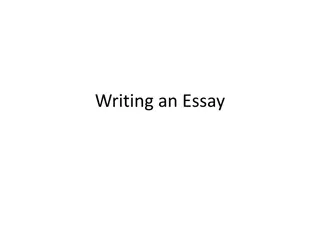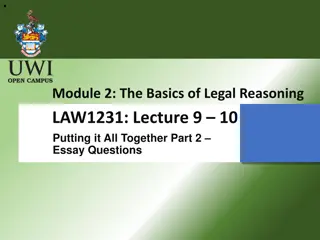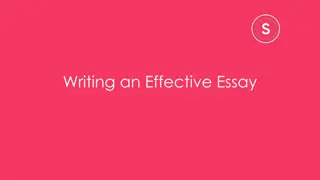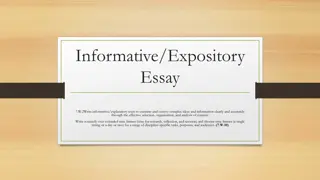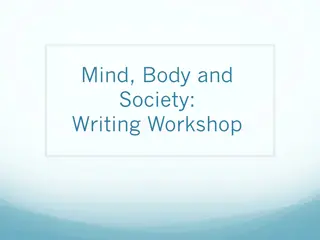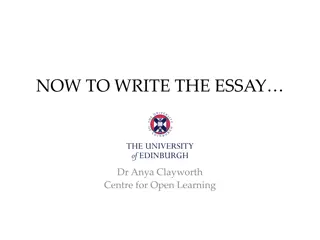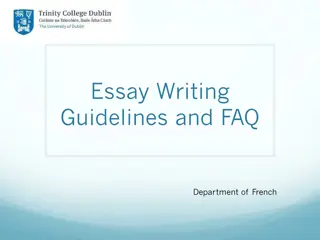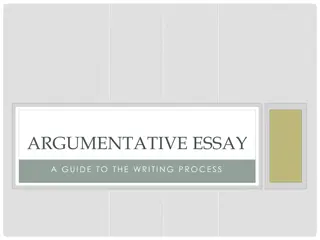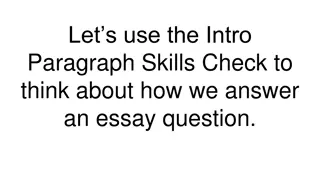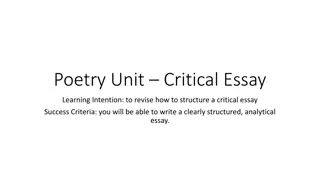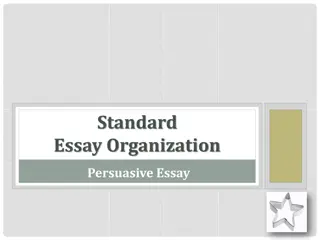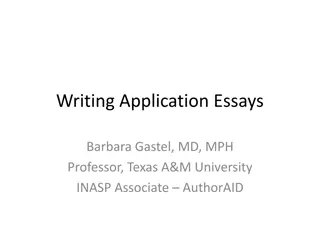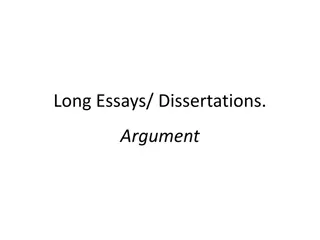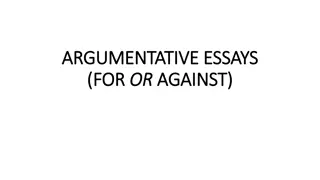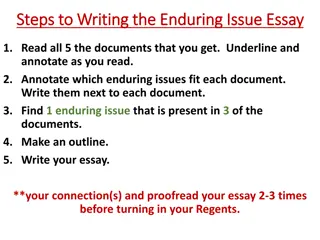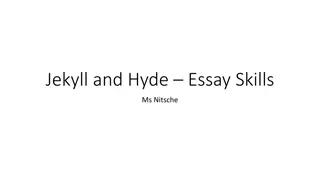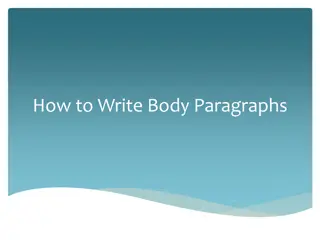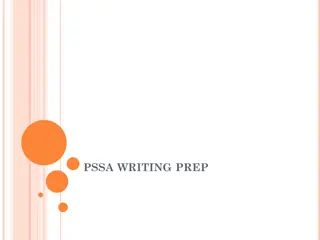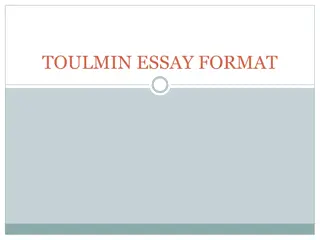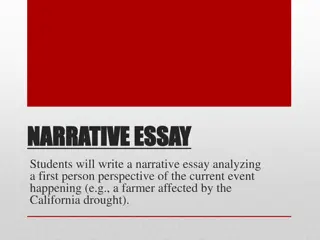Mastering the Art of Essay Outlining
Outlining is essential in essay writing as it serves as a roadmap, ensuring logical organization of ideas and supporting details. It helps with topic clarity, saves time, and breaks through writer's block. Learn how to create a structured argumentative essay outline efficiently.
Uploaded on Oct 07, 2024 | 0 Views
Download Presentation

Please find below an Image/Link to download the presentation.
The content on the website is provided AS IS for your information and personal use only. It may not be sold, licensed, or shared on other websites without obtaining consent from the author. Download presentation by click this link. If you encounter any issues during the download, it is possible that the publisher has removed the file from their server.
E N D
Presentation Transcript
Structure of Argumentative: Outlining
WHAT IS OUTLINING? Outlining is the road map for the essay. American writer Tom Wolfe said, By writing an outline you really are writing in a way, because you re creating the structure of what you re going to do. Once I really know what I m going to write, I don t find the actual writing takes all that long. Critical thinkers use outlines to organize their ideas and check the organization of their drafts throughout the writing process. Outlines represent an important element of the writing process not only for English essays, but also for essays in history, philosophy, economics, political science, etc. As the road map of the essay, outlines should do the following: Provide the thesis and most important details of the essay. Demonstrate a clear, logical organization of main ideas and supporting details. Include topic sentences but not every sentence in the essay/paragraphs.
WHY OUTLINE? Just like we need a road map when traveling to an unfamiliar destination, good writers create preliminary or rough outlines after they have generated enough ideas through prewriting to organize and develop their essays. Strong, thorough prewriting should develop more ideas than you can actually use in your essay so that you are able to select the most relevant and convincing ideas for your essay. Once you have settled on a thesis statement and your main supporting ideas, you can write a formal outline, creating the skeleton of your essay. Looking at your ideas this way can help ensure that: - Your main points are on-topic and directly support your thesis. - Your main points are logically organized. - Your most important ideas are emphasized and your less important ideas are subordinated. - Your main points have sufficient and relevant supporting evidence. Outlines also help writers: - Make the writing process easier since you have a road map for your essay to follow. - Break through writer s block for people who struggle with writer s block, it helps to first set up a structure with lower stakes and less pressure. - Save time writing your essay since you have a clear, focused plan to follow for your essay. - Ensure each part of your essay relates to the essay prompt.
HOW DO I DO IT? - Put the thesis statement at the top: it should be polished and be a complete sentence. - Use Roman numerals (I, II, III, IV, V, etc.) to indicate the main points/topic sentences which should be written in specific phrases or complete sentences (this is the P or Point of PIE). - Use capital letters (A, B, C, D, E, etc.) for the major supporting details; typically, writers should have at least two main supporting details for each point/topic sentence (the I or information of PIE providing evidence and the E or explanation of PIE providing analysis). - Use numbers (1, 2, 3, 4, 5, etc.) for sub-details clarifying and specifying your main supporting details.
Argumentative essay outline Writing an argumentative essay entails five basic steps: researching the issue, stating your position on the issue, arguing for your position, rebutting objections to your position, and resolving the issue. The outline of such an essay might look like this: Explanation of the problem Stating your position Argument supporting your position Rebuttal of expected criticisms Resolution of the issue
Explanation of the problem This very first step in constructing an extended argument or writing an argumentative essay is to become thoroughly acquainted with the complexity of the issue at stake. Your main concern shouldn t be that of defending the position that you may already have on an issue; your goal is to discover which of the available positions on the question is the most valid one. It is likely that researching the question may cause you to discard your original position. Excellent preparation involves looking at all sides of the coin. Not only does this lead you in determining which position to defend, it also familiarizes you with the possible arguments for or against that position. It also familiarizes you with alternative positions on the problem and the reasons that are supporting them. Most important, you ll understand the major criticisms of your position and the arguments supporting it, which you must successfully rebut as part of your essay.
Stating your position Before presenting your argument for your position, it is a good idea to indicate why the question at issue is an important one. The very fact that you are writing an argumentative essay suggests that there is an important unresolved or open question to be addressed. After you have carefully discussed the significance of the issue, you should state your position on it right at the start of your essay. This should be done similarly to the way a prosecutor does it in his or her opening statement at the beginning of a trial. Your research has already led you to the conclusion you ll be defending, so you should declare it as quickly as simply as possible. If it is a problem to be solved, you should make it clear that you believe your proposal will help solve it. There is no need to spend a lot of space up front addressing the complexity of the issue. The complex nature of the question will become sufficiently clear as you present your argument in support of your position.
Arguing for your position The section in which you argue for your position is the most critical part of your essay. Here is where you ll present the argument in support of your stated position. The argument for your position should look like a considerably expanded version of a standard-form argument. Typically, you should use one paragraph for each premise in your argument so that the reader is less likely to be confused about the parts of your argument. Remember that everything you say should help support the position, so you shouldn t include extraneous material, even if it would make the essay more entertaining or colorful. Set forth the strongest evidence you have in support of your conclusion, making all your premises as explicit as possible and arranging them so that they flow from one to the next in logical way. Use examples sparingly so that the reader is less likely to confuse an illustration with a part of the argument. Also, if possible, try to make your argument a deductive one, to increase the relative strength of the argument.
Rebutting Objections to Your Position The fifth criterion of a good argument, the rebuttal criterion, deserves a special status. A good argument should provide an effective rebuttal to all serious challenges of most arguments. This is the most neglected feature of most arguments. Almost any arguer can find relevant and acceptable premises and what appears to be sufficient number of premises to support a conclusion, but such an argument would not be good one unless it could also effectively answer the criticisms of those who challenge its merit. You should include effective rebuttals to the strongest of those criticisms as a part of your essay. If you do not have an effective response to them, then you probably should not be defending that position. You should have discovered this during the research phase of the argumentative essay assignment. Since only one position can be the most defensible position on the question, you should also be able to identify significant flaws in arguments supporting alternative positions on the issue. However, since it may not be possible to land a knockout blow against each of those alternative positions, you should at least make it clear that the argument for your position comes closer to successfully meeting all the criteria of a good argument that the arguments for the alternative positions.
Resolving the issue Since you ll have stated the conclusion of the essay at the beginning, you probably don t have to state it again at the end. However, you probably will want to show how the position you have defended resolves the question, solves the problem, or settles the conflict, which was the main impetus for writing the essay. You might also point out how the argument successfully meets all the conditions of a good argument, including the effective rebuttal of criticisms of your argument, the position it supports, and the arguments for the strongest alternative positions. Finally, you may wish to suggest areas related to the question where further research may be usefully conducted; but do not leave the reader with any doubt about where you stand on the issue.
It can be difficult to create a formal outline without some help. Here is a first step towards creating a more formal outline. Use this template and answer the guiding questions. After, revise what you produce into a formal outline. EXAMPLE
EXAMPLE Paragraph 2:
EXAMPLE Paragraph 3 and the conclusion:
This is a template to help you on the first step towards making a formal outline. Adjust for how many body paragraphs you decide to include. Please note: If your instructor has asked you to create a formal outline, you are not going to turn in this template. This template is designed to help you generate and organize the ideas you can then put into a formal outline. PRACTICE


